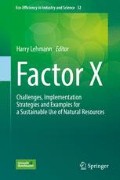Abstract
Resource stock and flow accounting has been increasingly applied on a country and city level. This paper elaborates on the possibilities to conduct a resource flow analysis even on a neighborhood/district level to identify, e.g., resource use related characteristics. Such resource patterns can be used to identify areas in different parts of a country or even larger geographical regions that are characterized by comparable types and amounts of resources entering the system boundaries. This identification might lead to archetypes that will help in deriving and applying policies, resource optimization strategies, etc. The approach presented in this paper stems from experiences made in the field of building stock modelling where archetypes are frequently used to characterize building stocks of a city or even a portfolio within a city. Furthermore, this approach is applied to develop energy and climate strategies for cities, renovation and maintenance strategies for real estate owners including investment planning. This paper reveals the shortcomings as well as the possibilities of resource pattern identification on a neighborhood/district level and closes with an outlook of necessary next steps to improve the quality of such an approach and increase the potential to use this approach as a strategic instrument.
Access this chapter
Tax calculation will be finalised at checkout
Purchases are for personal use only
References
Aksoezen M et al (2015) Building age as an indicator for energy consumption. Energ Buildings 87:74–86
Ascione F et al (2013) Analysis and diagnosis of the energy performance of buildings and districts: methodology, validation and development of urban energy maps. Cities 35:270–283
Barles S (2009) Urban metabolism of Paris and its region. J Ind Ecol 13(6):898–913
Baum S et al (2005) Typologies of advantage and disadvantage: socio-economic outcomes in Australian metropolitan cities. Geogr Res 43(4):361–378
Baum S et al (2007) Considering regional socio-economic outcomes in non-metropolitan Australia: a typology building approach. Pap Reg Sci 86(2):261–286
Booth AT et al (2012) Handling uncertainty in housing stock models. Build Environ 48:35–47
Creutzig F et al (2015) Global typology of urban energy use and potentials for an urbanization mitigation wedge. P Natl Acad Sci USA 112(20):6283–6288
Eriksson B (1993) Energisparpotentialer i bostadsbeståndet: värmebalansmodell. In: Statens institut för byggnadsforskning. http://www.lth.se/fileadmin/byggnadsmaterial/BFR-publ/BFR_skriftutg-1985.pdf. Accessed Mar 2017
Eurostat (2001) Economy-wide material flow accounts and derived indicators. A methodological guide. Statistical Office of the European Union. http://ec.europa.eu/eurostat/documents/1798247/6191533/3-Economy-wide-material-flow-accounts...-A-methodological-guide-2001-edition.pdf/. Accessed Mar 2017
Fabbri K et al (2012) Heritage buildings and energy performance: mapping with GIS tools. Energ Buildings 48:137–145
Kalmykova Y et al (2015) Resource consumption drivers and pathways to reduction: economy, policy and lifestyle impact on material flows at the national and urban level. J Clean Prod 132:70–80
Kavgic M et al (2010) A review of bottom-up building stock models for energy consumption in the residential sector. Build Environ 45(7):1683–1697
Kennedy C et al (2011) The study of urban metabolism and its applications to urban planning and design. Environ Pollut 159(8–9):1965–1973
Kladivo P, Halás M (2012) Quality of life in an urban environment: a typology of urban units of Olomouc. Quaest Geogr 31(2):49–60
Kleemann F et al (2016) GIS-based analysis of Vienna’s material stock in buildings. J Ind Ecol. doi:10.1111/jiec.12446
Mangold M et al (2015) Handling data uncertainties when using Swedish energy performance certificate data to describe energy usage in the building stock. Energ Buildings 102:328–336
Mangold M et al (2016) Socio-economic impact of renovation and energy retrofitting of the Gothenburg building stock. Energ Buildings 123:41–49
Mastrucci A et al (2015) GIS-based life cycle assessment of urban building stocks retrofitting-a bottom-up framework applied to Luxembourg. In: Johannsen VK et al (eds) Proceedings of EnviroInfo and ICT for sustainability 2015, Copenhagen, Denmark, September 2015. ASCR: Advances in Computer Science Research. Atlantis Press
Mata É (2013) Modelling energy conservation and CO2 mitigation in the European building stock. PhD dissertation, Chalmers University
Mata É et al (2013) A modelling strategy for energy, carbon, and cost assessments of building stocks. Energ Buildings 56:100–108
Niza S et al (2009) Urban metabolism: methodological advances in urban material flow accounting based on the Lisbon case study. J Ind Ecol 13(3):384–405
Ortlepp R et al (2015) Material stocks in Germany’s non-domestic buildings: a new quantification method. Build Res Inf 44(8):840–862
Österbring M et al (2016) A differentiated description of building-stocks for a georeferenced urban bottom-up building-stock model. Energ Buildings 120:78–84
Patrício J et al (2015) Uncertainty in material flow analysis indicators at different spatial levels. J Ind Ecol 19(5):837–852
Reinhart CF, Davila CC (2016) Urban building energy modeling–a review of a nascent field. Build Environ 97:196–202
Rosado L et al (2014) A material flow accounting case study of the Lisbon metropolitan area using the urban metabolism analyst model. J Ind Ecol 18(1):84–101
Sartori I et al (2009) Energy demand in the Norwegian building stock: scenarios on potential reduction. Energ Policy 37(5):1614–1627
Schebek L et al (2016) Material stocks of the non-residential building sector: the case of the Rhine-main area. Resour Conserv Recy. doi:10.1016/j.resconrec.2016.06.001
Schwab O et al (2016) Quantitative evaluation of data quality in regional material flow analysis. J Ind Ecol. doi:10.1111/jiec.12490
Schwarz N (2010) Urban form revisited-selecting indicators for characterising European cities. Landsc Urban Plan 96(1):29–47
Steadman P et al (2014) Energy and urban built form: an empirical and statistical approach. Build Res Inf 42(1):17–31
Swan LG, Ugursal VI (2009) Modeling of end-use energy consumption in the residential sector: a review of modeling techniques. Renew Sust Energ Rev 13(8):1819–1835
Author information
Authors and Affiliations
Corresponding author
Editor information
Editors and Affiliations
Rights and permissions
Copyright information
© 2018 Springer International Publishing AG
About this chapter
Cite this chapter
Österbring, M., Rosado, L., Wallbaum, H., Gontia, P. (2018). An Approach to Identify Resource Patterns on a Neighborhood Level. In: Lehmann, H. (eds) Factor X. Eco-Efficiency in Industry and Science, vol 32. Springer, Cham. https://doi.org/10.1007/978-3-319-50079-9_21
Download citation
DOI: https://doi.org/10.1007/978-3-319-50079-9_21
Published:
Publisher Name: Springer, Cham
Print ISBN: 978-3-319-50078-2
Online ISBN: 978-3-319-50079-9
eBook Packages: Earth and Environmental ScienceEarth and Environmental Science (R0)

